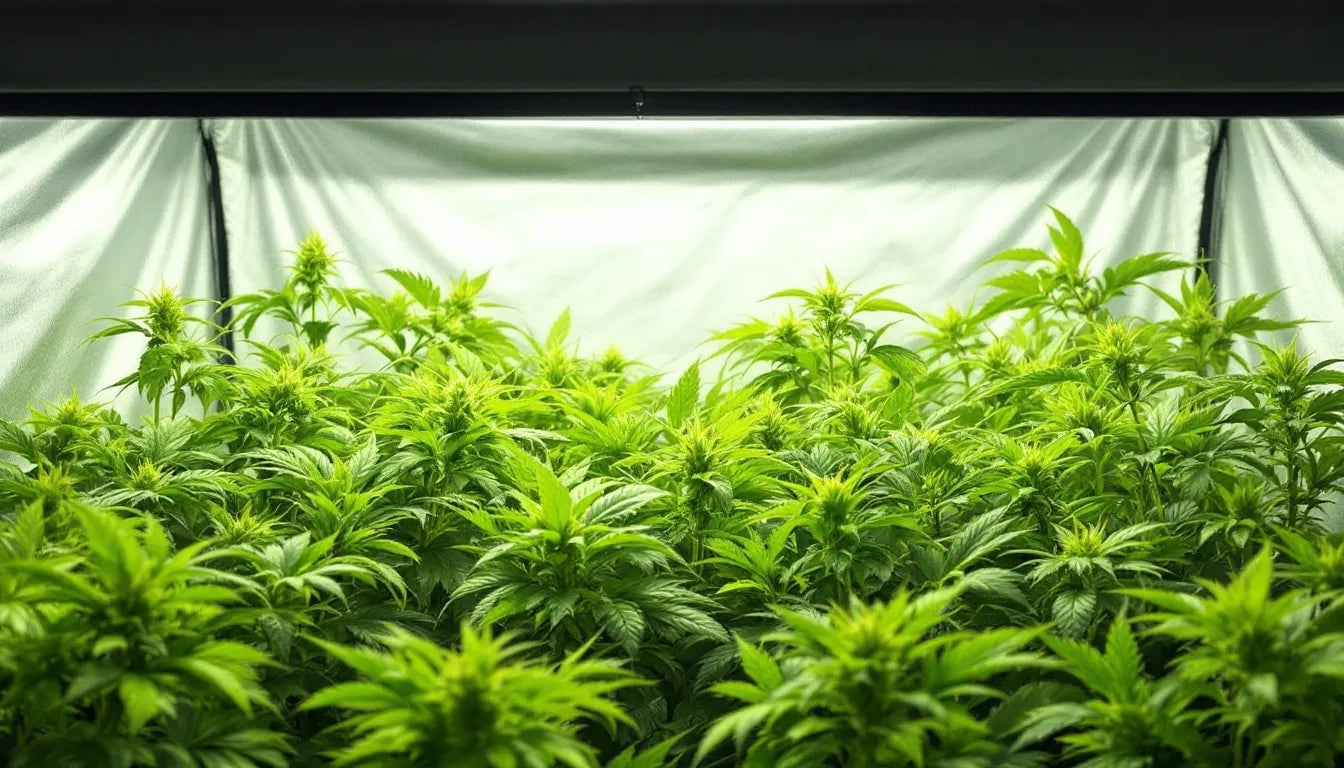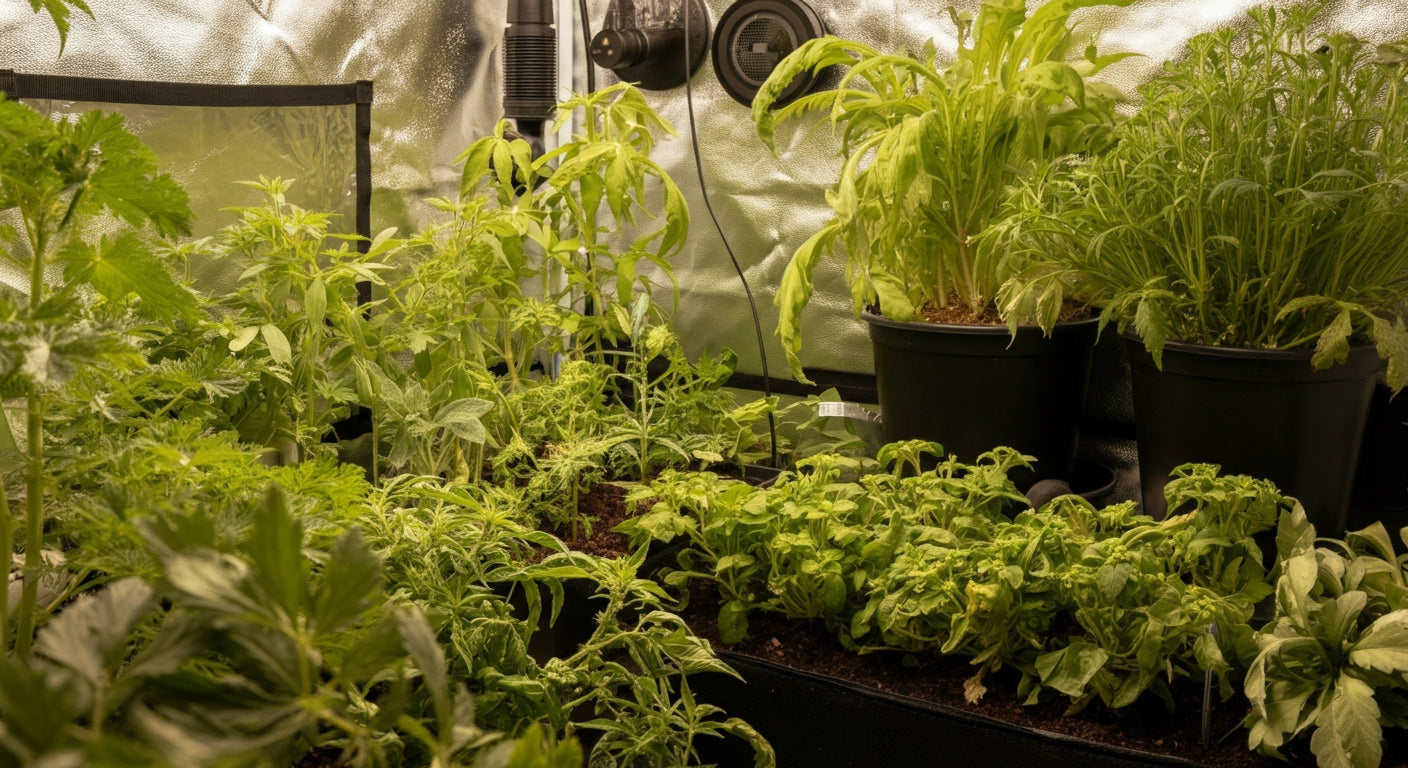
Do I Need a Fan in My Grow Tent? Essential Guide to Proper Airflow
If you're new to indoor growing, you might be wondering: "Do I need a fan in my grow tent?" The short answer is yes—absolutely. But understanding why fans are essential and how to set up the optimal airflow system can make the difference between struggling plants and a thriving garden. In this comprehensive guide, we'll explore everything you need to know about fans and ventilation for your grow tent setup.
Why Fans Are Absolutely Essential for Grow Tents
Fans aren't just an optional accessory; they're a critical component of any successful grow tent environment. Here's why proper airflow is non-negotiable:
Prevents Mold and Disease
Stagnant air creates a perfect breeding ground for mold, mildew, and various plant diseases. Without adequate air circulation, humidity levels rise, especially around dense foliage, leading to devastating outbreaks that can destroy your entire crop.
Strengthens Plant Stems
Plants grown in nature experience wind that causes their stems to sway slightly. This natural movement, missing in indoor environments without fans, triggers a response called thigmomorphogenesis—a process where plants develop stronger, thicker stems. Stronger stems mean plants better equipped to support heavy flowers or fruits during the flowering stage.
Regulates Temperature
Grow lights, especially HID systems, generate significant heat. Without proper airflow, temperatures can quickly rise to levels that stress or even kill your plants. Fans help distribute this heat evenly and exhaust excess warmth, maintaining an optimal growing environment.
Facilitates CO2/O2 Exchange
Plants consume carbon dioxide and release oxygen during photosynthesis. In an enclosed environment like a grow tent, the air around leaves can become CO2-depleted without circulation, severely limiting photosynthesis and growth. Fans ensure a continuous exchange of gases, keeping your plants breathing efficiently.
Prevents Pest Infestations
Many common grow room pests, such as spider mites and fungus gnats, thrive in stagnant conditions. Proper airflow makes the environment less hospitable to these unwanted visitors, reducing the likelihood of infestations.

Types of Fans for Grow Tents
Not all fans serve the same purpose in a grow tent setup. Understanding the different types and their functions will help you create the ideal ventilation system:
Inline Fans (Exhaust Fans)
Inline fans are the workhorses of grow tent ventilation, typically mounted outside or inside the tent and connected to ducting. They serve as the primary means of air exchange, pulling fresh air in and pushing stale air out.
Key Benefits:
- Powerful air exchange capability
- Can be paired with carbon filters for odor control
- Available in various sizes to match tent dimensions
- Create either negative or positive pressure environments
The Gorilla GXi Inline Fans represent the cutting edge of grow tent ventilation technology. With wireless control and adaptive technology that automatically adjusts to maintain ideal growing conditions, these fans deliver professional-level environmental control.
Oscillating Fans
Oscillating fans create air movement within the tent, ensuring no stagnant pockets develop and helping to distribute temperature evenly.
Key Benefits:
- Create gentle air movement throughout the canopy
- Help strengthen plant stems
- Prevent hotspots and cold pockets
- Reduce the risk of mold and pests
Clip-On Fans
These smaller, versatile fans can be attached directly to grow tent poles and positioned to provide targeted airflow where it's needed most.
Key Benefits:
- Space-efficient design perfect for smaller tents
- Adjustable positioning for targeted airflow
- Easy to relocate as plants grow
- Supplemental circulation in specific areas
Pedestal and Tower Fans
For larger grow tents, freestanding fans can provide broad air movement patterns and supplement other ventilation elements.
Key Benefits:
- Cover larger areas effectively
- Often include multiple speed settings
- Can provide airflow at different heights
- Useful for tents with multiple growing levels
Do You Need All These Fan Types?
While a comprehensive ventilation system might include multiple fan types, the minimum requirements depend on your grow tent size:
For Small Grow Tents (2'x2' to 3'x3')
- One 4-inch inline fan for air exchange
- One clip-on fan for internal circulation
For Medium Grow Tents (4'x4')
- One 6-inch inline fan for air exchange
- Two clip-on fans or one oscillating fan for internal circulation
For Large Grow Tents (5'x5' and larger)
- One 8-inch or larger inline fan for air exchange
- Multiple oscillating and/or clip-on fans for comprehensive internal circulation
Calculating the Right Inline Fan Size
Selecting the appropriate inline fan size is crucial for effective ventilation. The fan's power is measured in CFM (Cubic Feet per Minute), which indicates how much air it can move.
Basic CFM Calculation Formula:
- Calculate your tent's volume: Length × Width × Height = Cubic Feet
- For basic ventilation, aim to exchange all air every 1-3 minutes
- Divide tent volume by desired minutes for air exchange = Required CFM
For example, a 4'×4'×6' tent has a volume of 96 cubic feet. To exchange air every minute, you need a fan with at least 96 CFM.
Adjusting for Ventilation Restrictions:
When using carbon filters, ducting with bends, or other restrictions, add the following to your base CFM:
- Carbon filter: Add 25%
- Light cooling: Add 25%
- Ducting with bends: Add 25% (more for complex ducting)
- High ambient temperatures: Add 25%
So for our 4'×4'×6' tent example with a carbon filter, the adjusted CFM would be: 96 CFM + 25% = 120 CFM minimum requirement.
Best Fan Positioning for Optimal Airflow
Strategic fan placement is just as important as having the right fans. Here's how to position each type for maximum effectiveness:
Inline Fan Placement
- Top-mounted exhaust: Install the inline fan at one of the top ventilation ports of your tent to remove hot air, which naturally rises
- Bottom-mounted intake: Create passive intake ports near the bottom of the tent for fresh air to enter
- Corner positioning: When possible, position exhaust in a corner opposite from your passive intake to encourage diagonal air movement through the entire tent
Oscillating Fan Placement
- Above canopy: Position one oscillating fan above the plant canopy, angled slightly downward
- Below canopy: Place another oscillating fan below the canopy, angled upward (for larger tents)
- Indirect airflow: Aim fans at tent walls rather than directly at plants to prevent wind burn
Clip-On Fan Placement
- Mid-height positioning: Attach to tent poles at approximately mid-canopy height
- Distributed spacing: For multiple fans, space them evenly around the tent perimeter
- Adjustable angles: Point in slightly different directions to create circular air movement
Remember to adjust fan positioning as your plants grow. Seedlings require gentler airflow than mature plants, so you'll need to reposition and potentially add fans as your garden develops.
Common Airflow Mistakes to Avoid
Even with the right equipment, improper setup can compromise your grow tent's environment. Here are common mistakes to watch out for:
Direct Airflow on Plants
While airflow is essential, direct and continuous strong wind can stress plants, causing "wind burn" that manifests as curled, crispy leaf edges. Always aim for gentle, indirect air circulation.
Insufficient Exhaust Capacity
Undersized inline fans cannot remove heat and humidity effectively, leading to poor growing conditions and potential crop failure. Always size up rather than down when selecting exhaust fans.
Neglecting Lower Canopy
Many growers focus on upper canopy airflow while neglecting the lower portions of plants. This creates stagnant pockets that can harbor pests and diseases. Ensure airflow reaches all parts of your plants.
Improper Intake/Exhaust Balance
Without sufficient intake ports, exhaust fans can create too much negative pressure, causing tent walls to collapse inward. The Gorilla High CFM Kit provides support bars that prevent tent collapse from powerful exhaust systems.
Ignoring Nighttime Ventilation
Plants continue to transpire moisture at night, and humidity typically rises when lights are off. Maintain appropriate airflow 24/7, adjusting fan speeds rather than turning them off completely.
Advanced Ventilation Strategies
Once you've mastered the basics, consider these advanced approaches to optimize your grow tent environment:
Automated Climate Control
Modern grow tent ventilation can be fully automated with smart controllers that adjust fan speeds based on temperature and humidity readings. The GXi wireless system integrated with Gorilla Inline Fans allows precise environmental control via smartphone app.
Negative vs. Positive Pressure
Negative pressure (stronger exhaust than intake) helps contain odors but can stress tent seams. Positive pressure (stronger intake than exhaust) reduces dust infiltration but may allow odor leakage. Most growers aim for slight negative pressure as the optimal balance.
Seasonal Adjustments
Ventilation needs change with seasons. Summer growing requires more aggressive heat management, while winter conditions might need humidity maintenance. Adjust your fan setup seasonally for best results.
CO2 Enrichment Considerations
If you're using CO2 supplementation, you'll need to modify your ventilation strategy to retain CO2 while still managing temperature and humidity. This typically involves creating distinct ventilation cycles rather than continuous air exchange.
Setting Up Your Complete Ventilation System
Let's put everything together in a step-by-step guide to creating the ideal grow tent ventilation system:
Step 1: Gather Your Equipment
For a 4'×4' tent, you'll typically need:
- One 6-inch inline fan
- Carbon filter (if odor control is needed)
- Ducting and clamps
- Two clip-on or oscillating fans
- Temperature/humidity monitor
- Optional fan speed controller
Step 2: Install Your Exhaust System
- Mount your carbon filter inside the top of your tent
- Connect the filter to your inline fan with ducting
- Run ducting from the fan to an exhaust port
- Secure all connections with duct clamps
Step 3: Set Up Intake Ports
- Open appropriate intake ports on the lower portion of your tent
- Install mesh pre-filters over intakes to prevent pest entry
- Ensure intake ports have a combined area larger than the exhaust port
Step 4: Position Internal Circulation Fans
- Attach clip-on fans to tent poles at various heights
- Angle fans to create circular air movement
- Ensure airflow reaches all areas of your garden
Step 5: Test and Adjust
- Turn on all components of your ventilation system
- Measure temperature and humidity at various points
- Adjust fan speeds and positions to achieve ideal readings throughout the tent
Troubleshooting Common Airflow Issues
Even well-designed ventilation systems can encounter problems. Here's how to address common issues:
Problem: High Humidity
Symptoms: Readings above 70% RH, condensation on tent walls, wet surfaces Solutions:
- Increase exhaust fan speed
- Add additional circulation fans
- Consider a dehumidifier for severe cases
- Reduce plant density if overcrowded
Problem: Excessive Heat
Symptoms: Temperatures above 85°F (29°C), leaf curling, wilting Solutions:
- Increase exhaust fan speed
- Add additional intake ports
- Consider air conditioning for grow space
- Raise lights if possible
- Switch to cooler running lights
Problem: Tent Walls Collapsing
Symptoms: Tent walls drawing inward, zippers straining Solutions:
- Install Gorilla High CFM Kit support bars
- Increase size or number of intake ports
- Slightly reduce exhaust fan speed
- Ensure intake ports are fully open
Problem: Wind Burn on Plants
Symptoms: Curled leaf edges, taco-ing leaves, crispy tips Solutions:
- Redirect fans to blow against tent walls rather than directly at plants
- Reduce fan speeds
- Increase distance between fans and plants
- Use oscillating fans instead of stationary fans
Maintaining Your Ventilation System
Regular maintenance ensures your ventilation system continues to perform optimally:
Weekly Maintenance:
- Check and clean intake port pre-filters
- Inspect ducting for disconnections or damage
- Verify fan operation and clean visible dust
- Check tent for proper negative pressure (slight inward wall curve)
Monthly Maintenance:
- Remove and clean fan blades
- Check carbon filter for clogging
- Test temperature/humidity throughout the tent
- Inspect for any air leaks in ducting or tent seams
Quarterly Maintenance:
- Deep clean all fans
- Replace carbon filter if odor control is diminishing
- Check and replace any damaged ducting
- Verify CFM output is still meeting requirements
Conclusion: Fans Are Not Optional, They're Essential
The question isn't whether you need a fan in your grow tent—it's how many fans you need and how to position them for optimal results. Proper ventilation directly impacts every aspect of plant health, from structural strength to disease resistance to overall yield.
By implementing the strategies outlined in this guide and utilizing quality equipment like the Gorilla GXi Inline Fans, you'll create an environment where your plants can thrive. Remember that ventilation is a dynamic system that should evolve as your plants grow and environmental conditions change.
Investing in proper airflow is one of the most important decisions you'll make as an indoor grower. Your plants will reward your attention to this critical detail with robust growth, resistance to pests and diseases, and ultimately, impressive harvests.
So, do you need a fan in your grow tent? Absolutely, without question—and now you know exactly how to implement a ventilation system that will help your indoor garden flourish.

Lena Myles
I'm a mushroom enthusiast and home cook based in Oregon. I'm passionate about foraging and creating fungi-focused recipes, especially delicious, plant-based dishes using gourmet mushrooms like trumpet, shiitake, and oyster. When I’m not in the kitchen, you’ll usually find me wandering the woods in search of new wild flavors.


